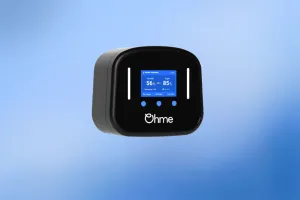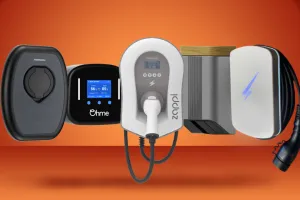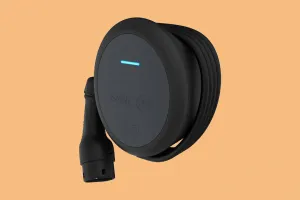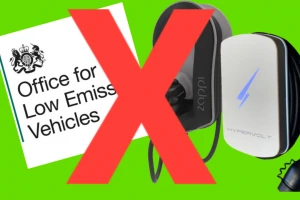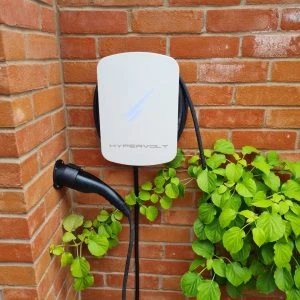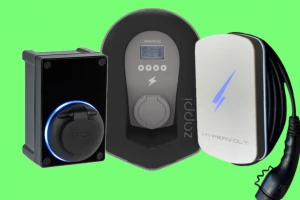The Sync EV is one of the smallest EV chargers on the market, designed by EVCP, a team of EV charge point installers. They wanted to make a charge point that was simple for installers to fit and easy to use for the client. It may be similar in appearance to the EO Mini 2, but the Sync EV packs in a lot more features, many seen in larger premium chargers.
For users who want something a little less obtrusive, then this may be the charger for you.
UPDATE: British General has recently acquired EVCP updating the range of products available. We will be reviewing the new charge points as soon as they become available.
Sync EV overview.
The Sync EV is a 7.4kw charge point and available in untethered (socket) and tethered (fixed lead) options. The unit is IP55 rated so fully waterproof when installed outdoors. The untethered model is very popular due to its small size and is very discreet, measuring in at 187 x 122 x 90mm. Supply cable can enter from the bottom or rear using the supplied weatherproof gland. Sync EV comes with a 3 year warranty which covers parts and labour in the event of a breakdown.
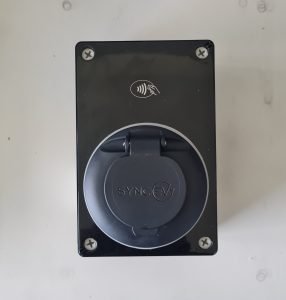
PEN fault protection
PEN fault protection comes built-in to the Sync EV which is really surprising for a unit of this size. Although this feature may not be high on the end users shopping list it’s a great feature to have as it makes installation simpler.
Older charge points like the EO mini would require an earth rod to be installed adjacent to the unit, or have an external PEN fault protection unit installed at the consumer unit position. Neither of these are required as the Sync EV has the safety feature built-in. Both of these alternatives will add cost to the installation and also take up more space.
The PEN fault protection device will switch power off to the charge point in the event of a fault on the neutral of the incoming supply cable to the property. Although this is an unlikely event it is more common than people think so the added protection is worthwhile.
If this fault occurs in some circumstances the metalwork of the vehicle may become live, and therefore be potentially dangerous.
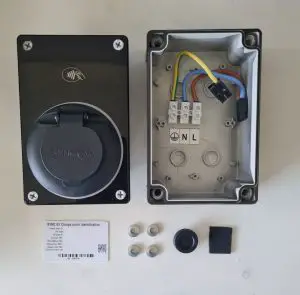
What’s in the box?
Load Balancing
Load balancing is a great safety feature which was first seen on the Myenergi Zappi, but is becoming more commonplace now, and is also found on the Sync EV.
Load balancing helps prevent the overload and rupture of the main fuse by lowering the charge rate to the car.
For example if the house has a 60 amp fuse and the rest of the house is consuming 40A, the charge rate will be reduced from 32A down to 20A saving the main fuse from rupturing.
Like the Myenergi Zappi a CT clamp is clipped on to the supply cables at the meter, and wired back to the SyncEV unit. This clamp reads the current usage in the home and relays the information to the Sync EV to adjust the charge rate.
Unfortunately, a wireless model like the one used for the Zappi is not available, so if your electricity meter is remote from your consumer unit this needs to be taken into account if you want to use this feature.
The CT clamp does have to be purchased separately (around £30-£35) but is well recommended.
RCD protection
The SyncEV has built in Type A + 6mA DC protection built-in offering the necessary additional protection required for EV chargers. This means that in most circumstances the charge only needs to be supplied by an MCB and no further equipment is required.
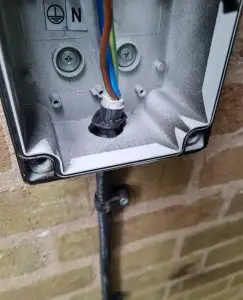
Sync EV has bottom and rear cable entry with the supplied weatherproof seal
Sync EV Smart capabilities
The Sync EV can be controlled via the mobile app for iPhone and android phones. The app allows users to setup timed charging schedules. These can be set to coincide with cheap rate electricity tariffs so your EV is charged at the lowest cost. For users on Octopus’s Go and Agile tariffs this can be done automatically by selecting them in the app as your tariff.
Vehicle Charge rates can also be adjusted in the app from 6A to 32A for those not opting for the load management option, or where maybe the charge point is installed in a garage from a separate consumer unit and worried about overload.
The LED halo ring brightness can also be adjusted between high, medium and low to make the unit less visible if required.
Connectivity
The Sync EV connects via WiFi to your router so it’s important to have a strong WiFi signal, failing that an ethernet cable can be hard wired or there is a 4G connectivity option available with an optional SIM card.
Sync EV models
The Sync EV is available as a Type 2 socket (you will require your own Type 2 charge lead) or tethered 5 metre fixed lead. The tethered lead model comes with a holster to insert the plug in when not in use. Unfortunately the fixed lead doesn’t wrap around the unit like the Zappi or Hypervolt but can hook over the holster to keep it tidy.
If you need to purchase a lead for your EV then make sure you buy one rated at 32A for a full electric vehicle, if you have a hybrid only a 16A is usually required. Most EVs will come with a lead supplied, but check with your dealer to make sure.
The Sync EV is currently available in black or white.
SyncEV cost.
The untethered SyncEV retails at £599, with the tethered model at £649. The CT clamp (recommended) is around £30-35. Installation costs will vary but may be cheaper than other models due to inbuilt PEN fault and RCD protection.

Sync EV installed
Verdict
The Sync EV is a great unit for something so small. It is really simple to fit so will please installers, and also keep installation costs down. For those wanting just a discreet socket and not a larger tethered unit it is highly recommended, especially if you don’t have solar, otherwise the Zappi or Hypervolt maybe the preferred choice.
If you are in the Shropshire or Wrexham areas and wish to have a Sync EV installed then contact us here. If not then find your local OZEV approved installer here.


